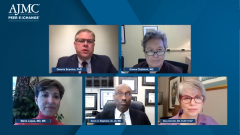
Payor Perspective on Coverage Decisions for DMTs in SMA
Kevin U. Stephens, Sr., MD, JD and Maria Lopes, MD, MS provide insight into the factors that payors must consider when creating and implementing policies on treatment coverage in SMA.
Episodes in this series

Dennis Scanlon, PhD: I would like to pull in our payer perspective, in particular Dr Stephens and Dr Lopes. There are these 3 therapies available, and we just discussed the trial evidence as well as some of the real-world evidence. Some have been approved as recently as August 2020. From that payer perspective, which factors do you weigh most heavily when making coverage decisions for these 3 therapies? What are your views on the evidence for any of them independently? How are you managing that process for the patient populations in your plans?
Kevin U. Stephens Sr., MD, JD: We have a review committee that is made of experts in areas that review all these policies, drugs, and treatments. They look at the evidence, the guidelines when they’re available, and the best practices, and then try to come up with the best scenario. From the payer’s perspective, the well-being of the patient is first and foremost on our mind. We try to do what we can for our patients because this is a very problematic illness. If you’re not aggressive early enough, the long-term sequelae can be really problematic and the utilization will go up and be more problematic. You have to balance that with evidence-based decisions.
As I mentioned, it’s very important to have peer-to-peer conversations with the reviewing medical director. There aren’t many cases. These drugs are new, so we have a lot to learn, and every patient is different, so you have to individualize your patient with what you have, what you know, and what resources are available in a rural area as opposed to a large metropolitan area. There may be different resources available for wraparound services, so that is when you have to engage and have dialogue. One of the most underutilized resources are the peer-to-peers. That’s a good way to create dialogue to collaboratively work together to create a care plan that addresses all these needs. We can put it into play without having a whole bunch of red tape with a lack of communication, lack of correspondence, and most important, lack of coordination.
Dennis Scanlon, PhD: Dr Lopes, do you want to jump in?
Maria Lopes, MD, MS: Absolutely. I couldn’t agree more. Things can get expedited when payers hear 2 key terms. One is expedited appeal, because the regulatory terminology implies that you fast-track that request. The other, to Dr Stephens’ point, is specialty match. That gets you to a dialogue with a similar physician to the requesting provider. These are 2 key terms that have a lot of implications for getting to the right physician and right level of expertise.
The data are changing so quickly. Payers develop medical policies, many times with thought leaders involved. But many times they start with a label indication and the preponderance of the evidence, which is usually based on the clinical trial data; policies are usually reviewed at least once a year. So much is happening in the world of SMA [spinal muscular atrophy] that it’s critically important to have the latest evidence. We all want to be evidence based, but there are a lot of unanswered questions. We have heard of the need for appropriate patient counseling as well. The struggle the payers are having is deciding how to sequence these options. I’m still seeing is a lot of limitations that perhaps reflect data gaps around combination use—like if you’ve been on Spinraza, even if you qualify for gene therapy and need to go off Spinraza. That’s an open area that we all need comfort around the appropriateness of the right patient and the right approach. It’s very nuanced, and it depends on not just the prediction of SMA copies but also what’s happening with that patient, their age, and what added incremental benefit these treatments are having.
Dennis Scanlon, PhD: When it comes to the available data, what is your perspective on the support for presymptomatic treatment or later-onset treatment as it pertains to the data available?
Maria Lopes, MD, MS: There is no question that the evidence is strong regarding the presymptomatic approach, but you need to make sure you’re selecting wisely. What do you consider in that journey that may not be the end all? What do you add and when do you add it? That’s where more data are needed to help understand the sequencing. Oral therapy is easier and less costly. Risdiplam has a lower annual cost than nusinersen. It’s also much easier to administer given that 1 is intrathecal while the other is oral. It’s important to get patients to that expertise that hopefully can counsel them appropriately. Unfortunately, what you’ve lost, you’re not going to regain. An approach that also helps the patients and their families understand the potential for some of these treatments is important.
Transcript edited for clarity.
Newsletter
Stay ahead of policy, cost, and value—subscribe to AJMC for expert insights at the intersection of clinical care and health economics.

























































